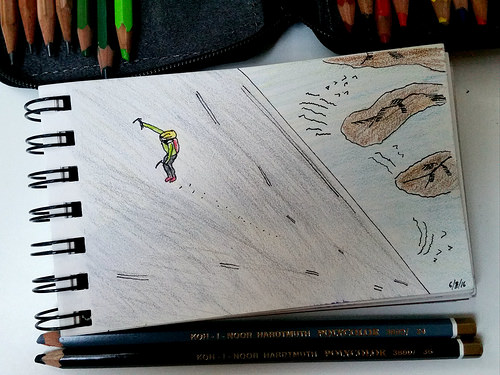
Infinite Spur Solo. (All rights reserved)
Go ahead and grumble, if you want to, that mountaineering and climbing isn’t what it was in the 1960s in Yosemite or the Himalayas of the 1950s, or even that exploration is actually dead. Go ahead. But you might be missing some of the more amazing things happening in climbing.
For instance: fast-and-light ascents are being claimed with greater frequency (that’s not necessarily taking the fun out of sufferfests, for those of you fans of alpine suffering), routes like the Compressor on Cerro Torre have gone free, long traverses are being claimed from the Mooses Tooth to the Mazeno Ridge, lengthy linkups are dispatched in hours rather than days, and women are demonstrating an unquestionable prowess in alpinism.
Still, for the last couple of years, nothing has wowed me more than the solo ascent by Ueli Steck of Annapurna’s South Face in October 2013. I actually found it chilling. I think I lived on a happy high over it for some time. So it’s been relatively dull, by comparison… until yesterday.
By now you should have heard about Colin Haley’s solo ascent of Mount Foraker’s — er, well, since McKinley is going rightly by Denali now we ought to call Mount Foraker more formally Sultana — Sultana’s Infinite Spur. If you haven’t heard click here for the recap and here for Colin’s personal take.
Flash
Just over a year ago, I named the first ascent of the Infinite Spur by Michael Kennedy and George Lowe in 1977 as an Honorable Mention among the top five Boldest Climbs in a Alaska. That climb took Kennedy and Lowe 14 days to navigate and deal with the conditions before topping out on Sultana’s north (and higher) peak.
But as Colin points out, no one had yet soloed the Infinite Spur. Other significant lines on Denali had, of course, been done alone. But Sultana has often been overlooked.
Colin’s experience here was also a powerful footnote to say that the climb is only half done upon reaching the summit. He got to the top in under 13 hours, but it took days in low-visibility to descend to safety.
Bold Solo Ascents
I have always been attracted to great solo feats and performances. I like goalies in hockey and pitchers in baseball. They’re unique and critical role to their team can’t be overplayed. A shutout and a perfect game are the pinnacle for those athletes.
In climbing, partnerships are highly valued. Teams are celebrated. And most of all, they are best experienced with teammates; because there is always more to climbing than climbing, just as there is more to fishing than fishing. And in regards to the Infinite Spur, even Steve House and Rolando Garibotti pulled off a lightning ascent in 2001.
But once in a while, someone like Reinhold Messner, Johnny Waterman, Ueli Steck, and, heck, even Alex Honnold, need to try something different.
Climbing is a game and the scenarios and the rules change (perhaps terms is a better word than rules), and the challenge is different. The failure and the accomplishment is weighed differently. Decisions are praised and criticized in that context.
It’s a matter about style, ultimately. Colin demonstrated boldness and style. I don’t recommend anyone follow his footsteps and approach, but when the next climber is ready, hopefully their judgment is sure and fortune will be with them.
Thanks again for stopping by. If you enjoyed this post, please consider following The Suburban Mountaineer on Twitter, Facebook, and Instagram.
